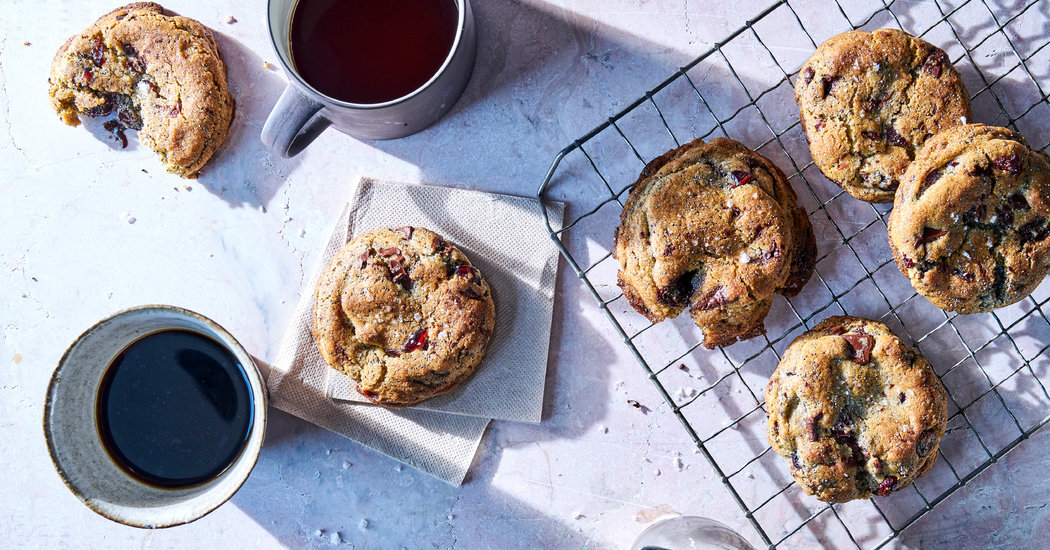
It takes me forever to get anywhere in Paris. It’s not the traffic, or the strikes — which are almost as reliable as the church bells tolling the hours — or the weather, or the bumpy cobblestone streets. It’s the pastry shops: There are so many of them, and I can’t keep myself from lingering in front of their windows. I’ve been stopped hundreds of times by the sight of cakes and tarts, small pastries of all shapes, cannelés browned to a burned-sugar patina and colorful macarons, of course. I’m an easy mark when it comes to sweets, which is why it’s odd that in my decades-long wanderings I’ve stopped for cookies only once. And that time, they weren’t even in a patisserie.
The cookies that called to me were so distinctive that even though they were on a back counter, I spotted them through an open door. They were made by Moko Hirayama, and they were in Mokonuts, the small, spare, breakfast-and-lunch-only restaurant that she runs with her husband, Omar Koreitem, in the 11th Arrondissement. Koreitem, whose first job out of culinary school was at the Michelin-starred restaurant Daniel in New York, and whose cooking is influenced by the places he has lived and worked — Lebanon, France, the United States and Britain — is in charge of all things savory, turning out elegant dishes in a kitchen the size of a van. And Hirayama (who grew up in Tokyo and San Francisco; went to college in New York, where the couple met; and kept a poster of a Pierre Hermé macaron on the wall of her office when she was a lawyer) does all the baking of breads, chubby loaf cakes, flaky fruit crostatas and those cookies.
The cookies are thick and chunky, even pucklike; craggy and rough around the edges; neither dainty nor unreasonably large. Some are smudged with chocolate; some have sesame seeds; all bear the marks of the baker’s hands. It was the ones with chocolate that interested me most. As an American baker, I knew that the inspiration for them must have been the classic chocolate-chip cookie, yet they were nothing like the usual. From their looks, I guessed they’d be good; I couldn’t have guessed that they’d turn into a meditation on the genre.
I bought a few and nibbled on them as I walked around that afternoon. When I got home, I found myself hefting the cookies, turning them over in my hands, paying attention to their color, breaking them in half to see if they snapped or bent and tasting them as if I were judging them for an award. They had qualities I prize. For starters, these were no store-bought chips. Instead, the cookies had chunks, shards and bits of fine chocolate that spread and melted under the oven’s heat, so that they were an unpredictable pleasure. They had salt, an ingredient that magnifies the flavors of butter, chocolate and brown sugar, but they weren’t salty. The edges were crisper than the middles, which were soft but fully baked. And the cookies were deeply golden brown, as I’m convinced all pastries should be.
The cookies looked rustic, but they were so carefully considered that I knew they’d have a back story, and many months and countless cookies later, I called Hirayama to discover it. I wasn’t surprised when she revealed that as she was teaching herself to bake, she’d go through “phases of obsession,” periods when she’d make exhaustive studies of a single recipe. During the time when she was trying to master the cookie that would be the ideal one for her, she kept a detailed chart of her tests and retests, using a different colored pencil for each trial. The cookie she came to years ago has become the base of many inventions, including the rye-cranberry chocolate-chunk cookie, my favorite.
Like all good — and obsessive — bakers, Hirayama has a rationale for everything she does with these cookies: “I shape them between my palms because I want each one to be uniquely uneven,” she explains; and they’re pressed when they come from the oven, so that they spread and crack some more. She’s equally precise about why each ingredient is included: The cranberries are a bit sour, and they offset the cookie’s sweetness; the chocolate is bitter, another guard against the cookie’s being too sweet; and the rye flour, well, it makes the cookie a little more tender, but it found a place in the mix because Hirayama was attracted to its beautiful gray color. Like a classic chocolate-chip cookie, the dough has a blend of white and brown sugars, but unlike other members of the classic’s family, this one has poppy seeds, lots of them. They speckle the cookie, look tweedy and autumnal and taste just this side of knowable — there’s a mystery about them. Hirayama says she added them to make the cookie crunchy, and they do. They also make it impossible to ignore. One more reason it takes such a long time to go a short way in Paris.
Dorie Greenspan is the On Dessert columnist for the magazine. She has won five James Beard Awards for her cookbooks and writing. Her new cookbook, “Everyday Dorie: The Way I Cook,” will be published in October.
Sign up for our newsletter to get the best of The New York Times Magazine delivered to your inbox every week.




